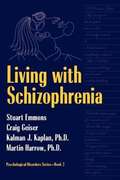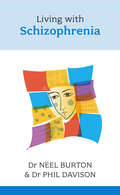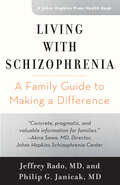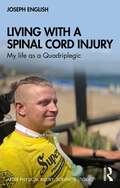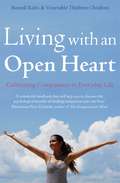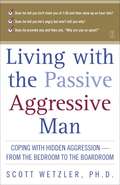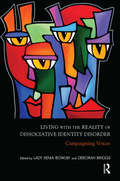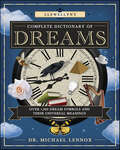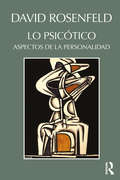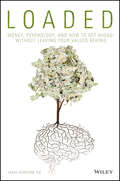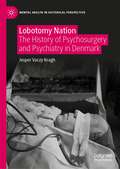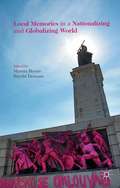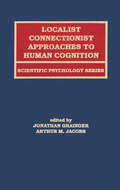- Table View
- List View
Living with Schizophrenia
by Stuart Emmons Craig Geiser Kalman J. Kaplan Martin HarrowIn the words of two individuals suffering from schizophrenia (Geiser and Emmons), this book gives first-hand insight into the process and effects of the disease. Throughout the narratives, poetry, and artwork, Kaplan and Harrow (psychotherapists who have worked professionally with Geiser and Emmons) add comments illuminating the meaning and psychological significance of the stories. This is the second book in the Psychological Disorders Series, each covering a single mental health disorder from the perspective of the sufferers themselves. It is written in a manner that will make the information accessible to family, friends, caretakers, and -- in this particular book -- to those who actually have schizophrenia.
Living with Schizophrenia
by Neel BurtonThere is a perception that schizophrenia is both uncommon and impossible to treat. In fact, it affects about 650,000 people in the UK, 2.2 million in the US, and some 50 million globally; and, the treatment success rate with today's medication and therapy can be high.It affects men and women in equal proportions, but often appears earlier in men. Symptoms are often terrifying and include visual and auditory hallucinations and acute paranoia, which may leave sufferers withdrawn, and incomprehensible or frightening to others.Living with Schizophrenia aims to fill a gaping hole in the market for information and self-help guides by addressing the needs of people with schizophrenia and their carers, relatives, and friends. Topics include:Authoritative description of what schizophrenia is and isn'tInformation and support for families and friends; how they can helpDiagnosisPhysical treatmentsPsychological treatments (talking therapies)Social interventionsFurther help
Living with Schizophrenia: A Family Guide to Making a Difference (A Johns Hopkins Press Health Book)
by Philip G. Janicak Jeffrey RadoA concise, up-to-date consumer guide for people who have schizophrenia and their families.An estimated 51 million people worldwide have schizophrenia, 2.2 million of them in the United States. While early diagnosis and appropriate treatment improve the long-term prognosis, schizophrenia is a disease that is difficult to manage. In Living with Schizophrenia, Drs. Jeffrey Rado and Philip G. Janicak, specialists in treating people who have schizophrenia, offer an easy-to-read primer for people with the disorder, along with their families and other caregivers. Drawing on their combined sixty years of clinical and research experience, Drs. Rado and Janicak define schizophrenia and explain what is known about its causes discuss the difference between negative symptoms (such as lack of emotion and social withdrawal) and positive symptoms (such as hallucinations, delusions, and thought disorders) describe medication and psychosocial and behavioral treatments—and the importance of early diagnosis and treatment for better long-term outcomes explain what people with schizophrenia and their families can do to help keep the person well explore how schizophrenia affects the entire family detail medical conditions that people with schizophrenia are more likely than other people to have—including heart disease, obesity, and diabetes offer key takeaway points for every topicDesigned for the lay reader and based on the most recent medical literature, Living with Schizophrenia offers information and understanding to help people coping with this often misunderstood disorder to best achieve recovery and healing.
Living with a Black Dog
by Matthew Johnstone Ainsley JohnstoneAs beautifully illustrated as it is touching, this second book from Matthew Johnstone, author of I Had a Black Dog, is written for those who care for those suffering from depression - friends, family members, colleagues, and even therapists. Using wonderful illustrations and the image of Churchill's infamous 'black dog', Matthew and his wife Ainsley offer a moving, inspirational and often humorous portrait of life with depression - not only for those suffering from it themselves, but for those close to them. Living with a Black Dog speaks directly to the carer and offers practical and sometimes tongue-in-cheek tips on helping the depression sufferer, such as 'Socks have little do with mental health. If people could just "snap out of it" they would.' and 'Encourage any form of regular exercise. Fitness robs the Dog of its power'. Based on their own experiences, Matthew and his wife Ainsley treat the subject of depression sympathetically, hopefully and, most importantly, humorously.
Living with a Spinal Cord Injury: My life as a Quadriplegic
by Joseph EnglishJoseph English was living his best life when a car accident changed everything. He suffered life changing injuries, and the doctors told him there was no chance of recovery. Facing life as a quadriplegic, Joe lost his business, his romantic partner, and, for a while, his will to carry on. His story, told with extensive contributions from his family and friends, charts his journey from being dead at the roadside to finding something to live for as he recounts his progress from injury to survival. With absolute candour, Joe tells the whole story of his accident, his rehabilitation, and his recovery. Full of advice and suggestions from professionals in the rehabilitation journey, this book is remarkably frank about the struggles Joe has endured, and the times when he felt as if life wasn’t worth living. It addresses all the most difficult issues around life after paralysis, including loss of identity and letting go of the past, as well as providing practical information on topics such as assistive technology, financial claims and legal support. It also outlines the various roles of those in the rehabilitation team. His doctors and specialist practitioners give their unique perspectives into their processes and procedures, helping to demystify them, while Joe’s family and friends ask the kinds of questions readers will be asking too, making this an invaluable guide to what to expect for anyone going through a similar experience. The book shows – by lived example – that there is always more to live for. It is essential reading for those with paraplegia, quadriplegia and other spinal injuries, and their families, friends and care-givers. It is also valuable for neuropsychologists, neurologists and other rehabilitation therapists, as well as students in medicine, nursing, allied health and neuropsychology.
Living with an Open Heart: How to Cultivate Compassion in Everyday Life
by Thubten Chodron Russell KoltsLiving with an Open Heart contains brief readings which blend Buddhist and western psychology. It thoughtfully presents ideas and techniques drawn from Buddhism, western psychological approaches, as well as the authors' personal experiences in working to develop compassion in their own lives and in their work with others. Designed to be easy to dip into, this fascinating book is organised into brief chapters to include discussions, reflections and contemplations, personal stories, and specific techniques for deepening compassion. Each chapter provides fuel for thought and contemplation as the reader goes through his or her day, inspiring their motivation to be compassionate, helping them to understand compassion, and giving them specific methods for applying it in their lives.
Living with the Enemy: Coping with the stress of chronic illness using CBT, mindfulness and acceptance
by Ray Owen‘This isn’t living, this is just existing.’ A long-term physical health condition – a chronic illness, or even a disability – can take over your existence. Battling against the effects of the condition can take so much of your time and energy that it feels like the rest of your life is ‘on hold’. The physical symptoms of different conditions will vary, as will the way you manage them. But the kinds of psychological stress the situation brings are common to lots of long-term health problems: worry about the future, sadness about what has been lost, frustration at changes, guilt about being a burden, friction with friends and family. You can lose your sense of purpose and wonder ‘What’s the point?’ Trapped in a war against your own illness, every day is just about the battle, and it can seem impossible to find achievement and fulfilment in life if the condition cannot be cured. It doesn’t have to be like that. Using the latest developments in cognitive behavioural therapy (CBT) which emphasise mindfulness and acceptance, and including links to downloadable audio exercises and worksheets, this book will show you how you can live better despite your long-term condition. It will teach you to spot the ways of coping that haven’t been working for you, how to make sure that troubling thoughts and unwanted feelings don’t run your life, how to make sense of the changes in your circumstances, to make the most of today and work towards a future that includes more of the things that matter to you. If you stop fighting a losing battle, and instead learn how to live well with the enemy, then – even with your long-term condition – you’ll find yourself not simply existing, but really living again.
Living with the Passive-Aggressive Man
by Scott WetzlerDO YOU KNOW ONE OF THESE MEN? The catch-me-if-you-can lover... Phil's romantic and passionate one minute, distant and cold the next. The deviously manipulative coworker or boss... Jack denies resenting Nora's rapid rise in the company, but when they're assigned to work together on a project, he undermines her. The obstructionist, procrastinating husband... Bob keeps telling his wife he'll finish the painting job he began years ago, but he never seems to get around to it. These are all classic examples of the passive-aggressive man. This personality syndrome -- in which hostility wears a mask of passivity -- is currently the number one source of men's problems in relationships and on the job. In Living with the Passive-Aggressive Man, Scott Wetzler draws upon numerous case histories from his own practice to explain how and why the passive-aggressive man thinks, feels, and acts the way he does. Dr. Wetzler also offers advice on: How to avoid playing victim, manager, or rescuer to the "P-A" How to get his anger and fear into the open How to help the "P-A" become a better lover, husband, and father How to survive passive-aggressive game playing on the job Living with a man's passive aggression can be an emotional seesaw ride. But armed with this book, you can avoid the bumpy landings.
Living with the Reality of Dissociative Identity Disorder: Campaigning Voices
by Xenia BowlbyThis book brings together the threads that make up the campaign for people with Dissociative Identity Disorder (DID). It is based on a Campaign Day for survivors organised by the Paracelsus Trust to raise awareness of DID.
Living, Loving and Loss: The Interplay of Intimacy, Sexuality and Grief (Death, Value and Meaning Series)
by Brad DeFord Richard B. GilbertOne of the unspoken aspects of mourning concerns the ways that loss affects our intimate relationships and our sexual expressiveness. This text opens these subjects for conversation, with the aim of promoting the trust, care, and respect that enable us to be vulnerable. It purposefully covers a range of topics, including: (1) the meaning of intimacy and the significance of sexuality, providing a basis for the use of these terms throughout the book; (2) death, grief, and differences in sexual orientation, including death and intimacy in the lesbian, gay, bisexual, and transgender (LGBT) community and the losses endured by young people due to gender issues; (3) loss of relationship and restoration of intimacy in families, including pharmacological effects on the grief processes of widowers; grieving a not-so-loved parent; the "layered losses" of infertility and intimacy; and the tolls of war--intimacy and sexuality challenges for soldiers and their families; (4) adjusting to life's losses associated with aging or illness or infirmity, including Alzheimer's and dementia-related illnesses, physical health losses after 50, and intimacy, sex, and hospice--self-determination and dignity at the end of life; and (5) religious bases that have shaped our perspectives for understanding intimacy, sexuality, and healing after loss, and which give us hope--including the spiritual reflections of a rabbi and a Christian voice in defining what is right. Set in a framework that is both psychological and spiritual, the well-researched contributions are intended to acknowledge these experiences both professionally and personally. The book concludes with an extensive bibliography, valuable for research and reference. This book will be of value in undergraduate and graduate courses on thanatology, as well as for anyone interested in knowing more about grief--both those currently bereaved and those who wish to support others in mourning. The contributors appreciate both the importance of our capacities for intimacy and sexuality and our inhibitions and hesitations in giving voice to our needs and concerns, perhaps especially when we are grieving. The information and compassionate understanding they provide encourage us to bridge the gap between the secret and the private and to share what is close to our hearts.
Llewellyn's Complete Book of Lucid Dreaming: A Comprehensive Guide to Promote Creativity, Overcome Sleep Disturbances & Enhance Health and Wellness
by Clare R. JohnsonWake Up in Your Dreams and Live a Happier, More Lucid LifeA lucid dream is a dream in which you become aware that you're dreaming. It's a powerful opportunity to solve problems, create new possibilities, take charge of your own healing, and explore the depths of reality. This book provides a range of practical techniques and activities to help you bring the creativity and super-conscious awareness of lucid dreaming into your life.Join international expert Clare R. Johnson as she shares the most up-to-date lucid dreaming techniques on how to get and stay lucid, guide dreams, resolve nightmares, deepen creativity, and integrate dream wisdom into everyday life. Drawing on cutting-edge science and psychology, this book is packed with inspiring stories of life-changing lucid dreams and fascinating insights into topics such as the ethics of dream sex, how to interact with lucid dream figures, and the nature of consciousness.Whether you're a person who barely remembers your dreams or a lifelong lucid dreamer, this in-depth guide is the perfect next step as you cultivate the power of lucid dreaming.Praise:"Dr. Clare Johnson has energetically led the way in revealing the limitless practical and spiritual potential of lucid dreaming, so far-reaching it can change the world. Her clearly-written book is destined to become essential reading for all those interested in lucid dreaming. It points out the essential phenomena of lucid dreaming, and then amazes us by opening its extraordinary major vistas to us, that reveal the true glory and limitless potential of our inner universe. This is a significant book."—Dr. Keith Hearne, the scientist who provided the world's first proof of lucid dreaming in 1975, and inventor of the world's first Dream Machine
Llewellyn's Complete Dictionary of Dreams: Over 1,000 Dream Symbols and Their Universal Meanings
by Michael LennoxDreams have an intelligence and purpose of their own, allowing your soul to reveal itself. By listening to the wisdom of your dreams, you can increase the satisfaction and success you experience in your waking life, make positive changes for a better future, and find a profound connection to your Higher Self.Llewellyn's Complete Dictionary of Dreams presents more than 1,000 cross-referenced dream symbols and their universal meanings to assist you in analyzing your unconscious mind. Join Dr. Michael Lennox as he explores the basics of interpretation and shows you how to integrate the subtle messages that arise while you sleep. The insights related to the specific symbols in this extensive guide are the keys to creativity, growth, and understanding.
Llewellyn's Little Book of Dreams
by Michael LennoxA pocket-sized guide to dreams and interpretation for improved understanding of your journey through life. Dreams are intensely personal, and they offer unparalleled insight to the depths of who you are and where you are in your journey. Llewellyn's Little Book of Dreams is a simple and concise reference guide, using language that speaks directly to the dreamer.Discover the basics of dream interpretation and the history of Freudian and Jungian approaches. Explore the contemporary scientific understanding of sleep and dreams, as well as tips for remembering dreams, dream journaling, and using dreams to enhance your creativity. With expanded dictionary style entries on common dream archetypes, this book provides symbolic meanings and ideas for connecting dream images to your personal life.
Lo Psicótico: Aspectos de la Personalidad
by David RosenfeldLO PSICÓTICO: Aspectos de la personalidad expone los resultados de la gran experiencia del Doctor David Rosenfeld como analista dedicado a pacientes psicóticos o profundamente perturbados y muestra cómo las fórmulas clínicas y teóricas resultantes de su trabajo pueden, del mismo modo, ponerse en práctica en pacientes que muestren un menor grado de perturbación. La primera parte cubre la teoría y el tratamiento clínico de los aspectos psicóticos de la personalidad, incluyendo un análisis de la literatura existente y una selección del material clínico que sirve para ilustrar el enfoque técnico del Dr. Rosefeld. El capítulo dedicado a los supervivientes de los campos de concentración muestra el modo en el que el concepto de núcleos autísticos encapsulados lleva a nuevos diagnósticos y procedimientos técnicos, al tiempo en el que otro artículo muestra las dificultades psicóticas que se presentan ante un trasplante de corazón. Varios ensayos subrayan la importancia de una detección exacta y del uso de la contratransferencia así como destacan el inestimable apoyo del supervisor en casos graves. La segunda parte desarrolla la noción del Dr. Rosenfeld del esquema corporal primitivo psicótico (PPBI), y muestra como dicho modelo ha probado su efectividad en campos como el delirio somático y la droga-adicción.
Lo mejor de mí: La guía para descubrirte, entenderte y quererte
by Elena Puig GuitartTransforma tu modo de pensar y actuar para conseguir ser una persona más serena, agradecida y con una vida plena. Aprender a ser la mejor versión de ti mismo es un camino de vida y de por vida. Un viaje que solo tú puedes realizar, que emprendes el día en que llegas a este mundo y que finalizas cuando te marchas de él, con la certeza de haber vivido con sentido. Esta guía práctica y accesible pone a tu disposición un conjunto de reflexiones y ejercicios que te ayudarán a recorrerlo con éxito y te enseñarán a: - poner el foco en lo que depende de ti y aceptar lo que no depende de ti; - escuchar tu cuerpo desde la consciencia; - poner la mente a tu servicio para planificar y focalizar; - reconocer y gestionar tus emociones; - no dejarte desanimar por tus miedos, detectar las creencias que ya no te sirven y desactivar las limitaciones sociales que te impiden crecer; - escribir tu propia historia con cada pequeña acción; - atender a tu niño interior desde tu adulto maduro; - dejar de lado el modo víctima, para liderar tu vida; - felicitarte y agradecer.
Lo que vio el perro: y otras aventuras
by Malcolm GladwellLos mejores reportajes del autor de los best sellers La clave del éxito y Fueras de serie. Sólo poniéndose en la piel de un perro, pensó Gladwell, podría destapar los secretos de César Millán, el «encantador de perros», capaz de calmar al animal más inquieto o enfurecido con un simple gesto. El ensayo que da título a este libro es un divertido y eficaz ejemplo del método gladwelliano, consistente en «mirar el problema con ojos ajenos». Gladwell nos trae historias de todos los rincones del mundo moderno: investiga las agridulces vidas de genios menores, audaces y obsesivos como el señor Heinz, responsable de que sólo exista un tipo de ketchup frente a docenas de variedades de mostaza; nos revela la trascendencia de la evolución del tinte capilar en la historia del siglo XX; compara los métodos de búsqueda de armas de destrucción masiva con los de detección del cáncer. Autor de tres best sellers que han dado un vuelco a nuestra manera de entender el mundo, Gladwell ha elegido los que consideraba sus mejores artículos, diseminados en distintos números de la mítica revista The New Yorker y nueva muestra de su insaciable curiosidad. Reseñas:«Un libro magnífico que reúne el estilo de escritura que ha hecho de Gladwell la extraordinaria figura que es hoy.»The Guardian «Gladwell es probablemente el mejor exponente de la reciente tendencia de libros que intentan revelarnos los secretos de nuestro complejo mundo a través del prisma de las ciencias sociales.»Financial Times «Algunos capítulos de Lo que vio el perro son obras maestras del arte del ensayo.»The New York Times «Malcolm Gladwell, escritor de éxito masivo, se ha convertido en uno de los grandes especialistas de nuestro tiempo en iluminar las zonas de sombra con su mezcla de periodismo, estudios científicos, historia y filosofía. Amante de llevar la contraria [...] Su objetivo es colocar junto a la certeza un signo de interrogación. [...] Gladwell define su trabajo como "no ficción pop". [...] Es un cheerleader de las ciencias sociales. [...] A la vista de los millones de lectores que han devorado sus libros, cabría decir que hay algo tranquilizador en ver ideas confirmadas por los estudios citados. También es curioso y seductor.»El País Semanal «Un mago en los libros de autoayuda. [...] Con más de 10 millones de ejemplares vendidos, Malcolm Gladwell es uno de los principales escritores "motivacionales", gurú del éxito y analista de "estrategias para triunfar". La clave del éxito, Inteligencia intuitiva, Lo que vio el perro y Fueras de serie son libros que ejecutivos y líderes de todo tipo devoran en los aeropuertos.»La Gaceta de los negocios
Loaded: Money, Psychology, and How to Get Ahead without Leaving Your Values Behind
by Sarah NewcombBased on decades of research and years of hands-on experience with people from all walks of life, LOADED is a must-read for anyone who finds themselves caught between the desire to thrive financially and the complex emotions and conflicting priorities that money so often brings to our lives. Inside, you will learn to: Check your stories. Pinpoint and change beliefs that hold you back. Choose your strategies. Learn how to align your money with your needs. Cultivate your value. Put your unique resources to use and earn more. Deeply researched, yet written in an approachable, conversational tone, LOADED offers insight into how your personal experiences have shaped your financial attitudes, and how you can build a healthier relationship with money.
Loaded: Women and Addiction
by Jill TalbotHaving an addiction can follow the path of a great relationship that goes sour: there's the first blush of romance, the seduction ("you know you want to"), and the downward spiral into either obsession or breaking free.Jill Talbot is no stranger to addiction. Part autobiography, part exposé, Loaded: Women and Addiction weaves Talbot's own battles with addiction with various addiction stories of other women. The result is a captivating, honest look at the allure of addiction-be it to sex, drugs, alcohol, food, adventure, or infidelity-and ultimately its betrayal.Though addiction can be seductive, if you're waking up with guilt or making choices that harm others, it's probably a clue that things are out of control. Throughout Loaded, Talbot's razor-sharp honesty, heartbreaking self-awareness, and resolve to reveal the difficult truth of her relationship with past and present addictions is humbling and sometimes gut-wrenching. In sharing her struggles and her resolve to attain control over her addictions, Talbot speaks her truth while sending a message of hope to women everywhere.
Lobotomy Nation: The History of Psychosurgery and Psychiatry in Denmark (Mental Health in Historical Perspective)
by Jesper Vaczy KraghThis book tells the story of one of medicine’s most (in)famous treatments: the neurosurgical operation commonly known as lobotomy. Invented by Portuguese neurologist Egas Moniz in 1935, lobotomy or psychosurgery became widely used in a number of countries, including Denmark, where the treatment had a major breakthrough. In fact, evidence suggests that more lobotomies were performed in Denmark than any other country. However, the reason behind this unofficial world record has not yet been fully understood. Lobotomy Nation traces the history of psychosurgery and its ties to other psychiatric treatments such as malaria fever therapy, Cardiazol shock and insulin coma therapy, but it also situates lobotomy within a broader context. The book argues that the rise and fall of lobotomy is not just a story about psychiatry, it is also about society, culture and interventions towards vulnerable groups in the 20th century.
Local Agency and Peacebuilding
by Stefanie KapplerWhile agency has become the new buzzword for researchers in the area of peace and conflict studies, it remains a concept that is both under-theorised and contested in terms of how it transforms the disciplines of Politics, International Relations and Peace and Conflict. In this book, Kappler develops a relational and spatial concept of agency, enhancing our understanding of the complex and subtle processes through which peacebuilding actors engage and interact with each other. Using the EU's engagement in peacebuilding in Bosnia-Herzegovina as a primary case study, this book investigates outlines competing discourse clusters in the interplay between the EU and local actors engaged in creative cultural activities. An investigation of the contested nature of agency in its ability to give meaning to peacebuilding highlights the potential of local actors to impact upon and resist institutional discourses. Kappler also conveys the challenges of peacebuilding in Cyprus where there is a lack of connection between local and international discursive spaces, whilst the more limited depth of international intervention in South Africa in turn suggests a more flexible set of actors as well as more dynamic interaction in the emergence of peace-related discourses. This book provides an original discussion of agency in relation to EU peacebuilding, exploring the subtle forms of interaction between actors and framing the analysis in ways that allow for practical application.
Local Memories in a Nationalizing and Globalizing World
by Marnix Beyen Brecht DeseureIn historical studies, 'collective memory' is most often viewed as the product of nationalizing strategies carried out by political #65533;lites in the hope to create homogeneous nation-states. In contrast, this book asserts that collective memories develop out of a never-ending, triangular negotiation between local, national and transnational actors.
Local Negotiations of English Nationhood, 1570–1680
by John M. AdrianLocal Negotiations explores the vitality of early modern local consciousness. Even in an age of emerging nationhood, English men and women were still profoundly influenced by and even drew their primary identity from the parish, the town, and the county. This book examines how early modern writers invoke local places, traditions, and ways of thinking to respond to the larger political, religious, and cultural changes of the period. The opening chapter establishes the historical basis of local identity and describes the ways in which it was transformed in the second half of the sixteenth century. Each of the succeeding five chapters then focuses on a particular author and historical moment, and explores how local habits of thought are invoked to respond to a specific national initiative (political centralization, religious uniformity, court culture, civil war, and empire). Together, these chapters illustrate both the pervasiveness of local discourse and the range of possible responses to nationhood that it engendered. "
Localist Connectionist Approaches To Human Cognition (Scientific Psychology Series)
by Jonathan Grainger Arthur M. JacobsThis volume provides an overview of a relatively neglected branch of connectionism known as localist connectionism. The singling out of localist connectionism is motivated by the fact that some critical modeling strategies have been more readily applied in the development and testing of localist as opposed to distributed connectionist models (models using distributed hidden-unit representations and trained with a particular learning algorithm, typically back-propagation). One major theme emerging from this book is that localist connectionism currently provides an interesting means of evolving from verbal-boxological models of human cognition to computer-implemented algorithmic models. The other central messages conveyed are that the highly delicate issue of model testing, evaluation, and selection must be taken seriously, and that model-builders of the localist connectionist family have already shown exemplary steps in this direction.
Localization and Its Discontents: A Genealogy of Psychoanalysis & the Neuro Disciplines
by Katja GuentherPsychoanalysis and neurological medicine have promoted contrasting and seemingly irreconcilable notions of the modern self. Since Freud, psychoanalysts have relied on the spoken word in a therapeutic practice that has revolutionized our understanding of the mind. Neurologists and neurosurgeons, meanwhile, have used material apparatus—the scalpel, the electrode—to probe the workings of the nervous system, and in so doing have radically reshaped our understanding of the brain. Both operate in vastly different institutional and cultural contexts. Given these differences, it is remarkable that both fields found resources for their development in the same tradition of late nineteenth-century German medicine: neuropsychiatry. In Localization and Its Discontents, Katja Guenther investigates the significance of this common history, drawing on extensive archival research in seven countries, institutional analysis, and close examination of the practical conditions of scientific and clinical work. Her remarkable accomplishment not only reframes the history of psychoanalysis and the neuro disciplines, but also offers us new ways of thinking about their future.
Localization and Quality Assessment of Project-Based Learning in China (Curriculum Reform and School Innovation in China)
by Xuemei XiaThis book provides a systematic assessment of the quality of Project-Based Learning (PBL) and proposes a diagnostic criteria framework for evaluating project design and implementation. It identifies key characteristics that vary as a result of differentiation. The book offers a feasible framework for implementing competency-based teaching on an international scale, drawing from our long-term exploration in China to address shortcomings in Chinese education. Furthermore, it delineates the boundaries and limitations of project-based design, facilitating professional learning in its implementation. Educational practitioners will gain multidimensional perspectives to develop their capacities and critically reflect on PBL&’s impact on students' learning processes.
